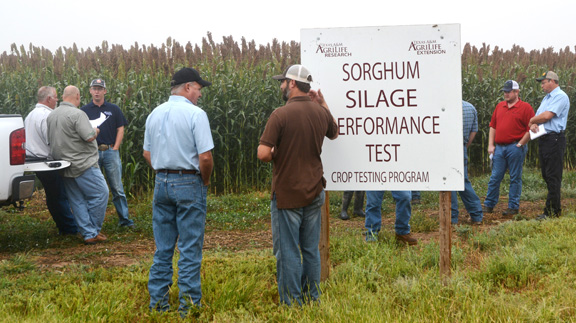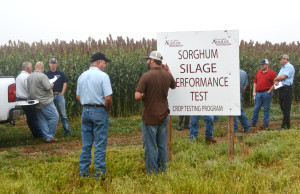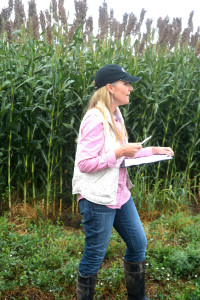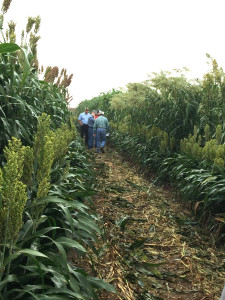Farm & Ranch
AgriLife Extension forage sorghum hybrid trial has special purpose

By: Kay Ledbetter
Data to be used for farm bill loan deficiency program
Writer: Kay Ledbetter, 806-677-5608, [email protected]
Contact: Dr. Jourdan Bell, 806-677-5600, [email protected]
AMARILLO – More than 100 forage sorghum hybrids from 13 commercial companies across the U.S. growing in a Texas A&M AgriLife Extension Service production trial have a unique role to play, according to an AgriLife Extension specialist.
In addition to forage yield and quality, the field trial on the Michael Menke farm east of Bushland will help evaluate the eligibility of sorghum varieties for the U.S. Department of Agriculture’s Farm Service Agency management assistance loans and loan deficiency payments based on grain yield and forage type, said Dr. Jourdan Bell, AgriLife Extension agronomist in Amarillo.
The Texas Panhandle Forage Sorghum Silage Trial conducted at Bushland historically has been used by the Farm Service Agency, or FSA, to update grain sorghum eligibility tables.
“This is the second year we’ve had this trial with Mr. Menke, which has allowed us to evaluate the hybrids under center pivot irrigation and managed for maximum production,” Bell said. “We have 100 different hybrids, and there are three replications of each, so it’s definitely a very big trial.”
“Last year grain yields were not collected from the trial, but they will be this year if requested by the company in order to update existing eligibility tables,” she said.
FSA characterizes sorghum in five classes: dual purpose having a yield potential equal to 100 percent of a hybrid grain variety; dual purpose having a yield potential equal to 80 percent of a hybrid grain variety; sterile; photoperiod sensitive and ineligible varieties.
Forage-only varieties are not eligible for loans, only loan deficiency payments, unlike dual-purpose varieties that are eligible for both, Bell said. Sorghum varieties are further categorized to determine their eligibility according to tannin or non-tannin and grazing or grain use.
Bell said the trial at Bushland also includes three varieties planted at different populations. The population for the larger trial was 100,000 seeds per acre, based on longtime research data. But the three selected varieties were also planted at 75,000 seeds per acre in order to evaluate performance and lodging at a lower population.
“Based on previous data, 100,000 seeds per acre is a good planting rate to optimize production, especially under irrigation, but there is the potential to enhance lodging with certain varieties. We realize that this is not a recommended population for many varieties, but we are trying to maximize production,” she said.
Bell said the trial has only received about 4.5 inches of irrigation this year due to the rain received from May through July. The field received 12.4 inches of rain since planting on June 24, but there has been 25 inches of rain since May 1. That was one reason for the late planting date – the field was under water much of the time until late June.
“We’ve had really good weather pushing this sorghum along,” she said.
But on the down side, Bell said the trial has been hit by sugarcane aphids and has been treated once.
Harvest is underway, but it will continue through next month as every hybrid is harvested for silage when it reaches soft dough, she said.
“With the forage sorghum silage, it is critical that we optimize harvest time for quality. Silage pit management and end-use quality is strongly affected by harvest stage,” Bell said.
“If the silage is harvested prior to soft dough without additional drying, increased moisture contents can result in amplified butyric acid levels in the silage pit, which reduces palatability. When harvest is delayed to hard dough, moisture is often less than 60 percent, which results in poorly packed silage pits and poor fermentation.”
She said with all the dairies, the forage sorghum silages are a great fit for this region because they can be produced with about half the water as corn silage.
“One of the things we have seen is quality varies among varieties. There are some brown mid-rib varieties that are very good and some that aren’t, the same with non-BMR varieties. That’s why this field trial is something really great to see and have everything in the same location to look at.”
-30-
Farm & Ranch
Acorn Toxicity

By Barry Whitworth, DVM, MPH
With the prolonged drought, most pastures in Oklahoma end up in poor condition. With the lack of available forage, animals may go in search of alternative foods.
If oak trees are in the pastures, acorns may be a favorite meal for some livestock in the fall. This may result in oak poisoning.
Oak leaves, twigs, buds, and acorns may be toxic to some animals when consumed.
To read more, pick up a copy of the November edition of North Texas Farm & Ranch magazine, available digitally and in print. To subscribe by mail, call 940-872-5922.

Farm & Ranch
Silver Bluestems

By: Tony Dean
There are a handful of grasses on North Texas grazing lands ranchers need to know, not because they are highly desirable, but rather because they are not of much value. I call them “decom” plants, which is am acronym for “Don’t Ever Count On Me.” Silver bluestem is a “decom” grass.
Silver bluestem is a perennial which grows in all areas of Texas. It can survive in almost all soil types, and in full sun conditions or in semi shade. It grows up to three feet tall and is easily recognized with the presence of the white fuzzy seed head. Also, one of the identifying characteristics of Silver bluestem is a bend in the stems at each node, causing the plants to take on a rounded shape as they mature.
To read more, pick up a copy of the November edition of North Texas Farm & Ranch magazine, available digitally and in print. To subscribe by mail, call 940-872-5922.

Farm & Ranch
Meanwhile Back At The Ranch

By: Rayford Pullen
Fall is here which means winter is closing in on us and before we officially get into winter, we need to make sure our factories are either producing or will be producing in a few months.
We have been pregnancy testing our cows this fall and if they are not bred or nursing a calf, we are bidding them adios. With annual costs somewhere between $900.00 and $1,000.00 per cow, those cows not producing a live weaned calf are costing us quite a bit.
To read more, pick up a copy of the November edition of North Texas Farm & Ranch magazine, available digitally and in print. To subscribe by mail, call 940-872-5922.
-

 Country Lifestyles2 years ago
Country Lifestyles2 years agoScott & Stacey Schumacher: A Growth Mindset
-

 Country Lifestyles8 years ago
Country Lifestyles8 years agoStyle Your Profile – What your style cowboy hat says about you and new trends in 2017
-

 HOME8 years ago
HOME8 years agoGrazing North Texas – Wilman Lovegrass
-

 Equine1 year ago
Equine1 year agoThe Will to Win
-

 Country Lifestyles5 years ago
Country Lifestyles5 years agoAmber Crawford, Breakaway Roper
-

 Outdoor9 years ago
Outdoor9 years agoButtercup or Primrose?
-

 Country Lifestyles8 years ago
Country Lifestyles8 years agoJune 2016 Profile – The man behind the mic: Bob Tallman
-

 Country Lifestyles8 years ago
Country Lifestyles8 years agoDecember 2016 Profile, Rusty Riddle – The Riddle Way







